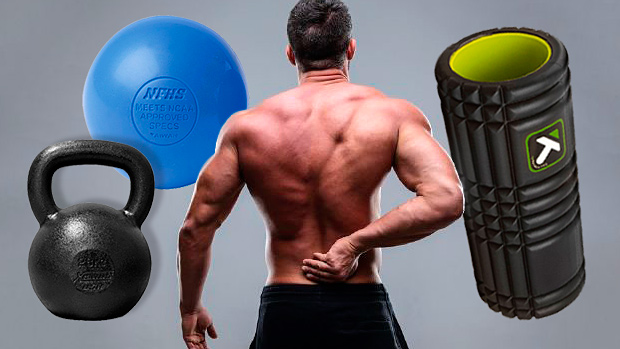When it comes to rehab there are many ways to achieve good results. But sometimes seemingly helpful techniques can be a waste of time, or worst case scenario, cause injury. This is especially true for self-myofascial release (SMR).
The number one rule in medicine is "do no harm" and that's exactly what some of these popular SMR techniques can do. Here are the ones that can go terribly wrong, along with alternatives that'll achieve the same goal without risks.

This is a popular one. And rehab pros are divided on it. Some say you can't deform dense fascial layers like the IT-tract (they're correct), but they'd be blind if they didn't recognize that a ton of people do get positive responses to rolling this piece of fascia.
While I'm not a believer in the mechanical model of musculo-fascial deformation, I'm a huge advocate of getting results. So in defense of IT band foam rollers, here's what's really going on when you do it:
By positioning the foam roller on the outside of your thigh on where you think the IT band is located, you're actually targeting the underlying vastus lateralis (lateral quadriceps) and biceps femoris (lateral hamstrings) musculature. Most people have no idea how to target, let alone locate, a functionally shortened area of musculature or symptomatic trigger point. Just because it hurts and is located on the side of your leg doesn't mean you're "treating" the IT band.
So if you're a fan of foam rolling this area, then whether you realize it or not, you're probably not on the IT band. You'd probably get long-term benefits by rolling a different area. Instead of trying to squash the IT band, target the quads and hamstrings directly so you won't need to constantly smash the same structures.
The Fix: Foam Roll the Quads and Hams
Forget the IT band. Target the vastus lateralis and biceps femoris directly. All you have to do is slightly change the position of your body over the foam roller. You'll get maximum benefit from SMR work in the lateral leg without continuing to be a slave to the IT band rolling.

The piriformis is notorious for wreaking havoc on people's asses. But if you're literally feeling the butt hurt, the piriformis probably isn't the origin of your pain. But it is a player in the dysfunctional movement spectrum.
And when a "do-it yourselfer" gets seriously butt hurt, he or she will try to remediate it with a lacrosse ball, soft-ball, or whatever ball they can find to smash the area and relieve the pain. Sure, self-sufficiency and body maintenance are good, but the lacrosse ball in the butt treatment isn't a permanent fix.
By placing a hard object right up against the notch in your butt where the pain seems to be stemming from (likely the sciatic nerve) you're essentially attempting to target a nerve with the lacrosse ball. And, just like the myth about breaking up scar tissue, a nerve isn't something you're going to "break up" no matter how much you believe in smashing or rolling it.
Doing this repeatedly creates the perfect opportunity to cause constant irritation. And if that's what's happening, then you most likely did it to yourself.
The Fix: Foam Rolling the Glutes
Your pain in the butt is most likely due to an instability issue in the lumbar spine or pelvis, and one of the key players to adding stabilization to this region is the gluteus maximus.
By targeting the whole glute with soft tissue work, you can increase the surface area of the SMR tool that's coming into contact with your backside. You'll also be directly working on the prime areas lacking in stability. Stick to the foam roller for butt rolling and skip the ball.

Some believe heavy loaded implements like kettlebells can be used for SMR by smashing them into the stomach and surrounding abdominal region to alleviate tightness. While muscular structure, such as the iliopsoas group, the internal and external obliques, and even the diaphragm itself are sometimes in need of manual manipulation in order to restore function, there are safer and more sane methods that will achieve the same goal.
When people smash their guts, a few anatomical considerations are overlooked that could potentially be dangerous for both orthopedic health and systemic health. There are visceral organs in the abdominal cavity, ones that your life kind of depends on.
And if you have a tough time identifying superficial structures like the IT band and quads, will you really be able to know the relative location of your organs? Hell, half of the therapists out there still "press and guess" when it comes to contacting the psoas and they're doctorally trained and educated. The cost-benefit ratio just doesn't add up in the case of the gut smash.
The Fix: Diaphragmatic Breathing Under Stretch
People get caught up in the idea that tissues and structures must be physically contacted in order to release and alleviate pain. Pain-science is one highly complex beast, but some of the basics show that tone and pain are largely neurologically based, and there are various stimuli that can reduce them without contact of the body. This internally dependent model can be tapped into using the stretch reflex, systemic diaphragmatic breathing, and positional reeducation.
Try half-kneeling hip flexor positional breathing mobilization, shown in the video, to see how this can benefit abdominal tone reduction without risking a bruised liver.

One of the most common areas people try to self-treat is the lower back. While the spine has the ability to be mobile in the three cardinal planes of movement, a majority of lower back pain is caused by the instability (or perception of instability) throughout segments of the spine, and also the stabilizing musculature surrounding the spine.
SMR is not really understood by even elite level trainees, and there's an assumption that all pain and soreness are caused by the same problems. Since the lacrosse ball on the bottom of the feet helps with alleviating symptoms in the plantar fascia, the ball must work for alleviating pain and soreness in the lumbar spine as well, right? Not quite, and here's why.
The spinal column is stabilized segmentally by small and intricate musculature called multifidus and rotatores. These structures are technically musculature because they can create mechanical tension, but really, they act as proprioceptors that sense changes in relative joint-by-joint stability, and also increased pressure and strain through segments. As these muscles become stimulated, they become quickly tightened and painful as a protective mechanism for your spine.
While the thoracic spine is a viable area to place a peanut or foam roller due to an area of the vertebra called the spinous process being at a specific angle that is protective over the sensory heavy multifidus being unwarrantedly stimulated, the lumbar spine's spinus processes in combination with the transverse processes differ.
When treating the areas locally with lacrosse or tennis balls, this angle makes the lumbar segmental stabilizers and sensory structures more susceptible to being set off. People try to self-treat and hurt themselves in the process, creating a vicious cycle of pain and dysfunction. Not the result you want when you pin a couple balls under your back.
The Fix: 3-Way Plank Progression
If your lower back pain keeps getting flared up, it's most likely a lack of stability rather than a lack of mobility. Adding more mobility to an already hyper-mobile and instable area is a recipe for disaster.
One of the most effective ways to create stability through the pillar (shoulders, hips, core) and maintain long-term movement pattern reeducation, is through this plank progression. Check out this 3-way plank series that includes the RKC plank and side plank, which increase stability through the four layers of the abs, iliopsoas, lateral hip group, and quadratus lumborum.

By no means should people be walking, stepping, or exerting force into one another with their feet. But let's just pretend walking on people was a viable practice. Do you really want your physical therapist taking his shoes off, having you lay on the ground while he steps on your triceps placing his full weight through your arm for soft tissue work?
It's impossible to use a calculated approach when placing the total weight of one body onto another body. The pressure is left up to gravity, making this an archaic treatment of idiotic guess work. It's blasphemous SMR, and it barely exists in the Eastern countries that invented this voodoo. Yet some people will still allow themselves to be doormats. We have hands as tools and brains for a reason – let's use them.
I blame the "no pain, no gain" mentality. People seem to think that healing requires pain. Yes, 200 pounds of somebody's bodyweight on your back or quads will hurt, but does it actually produce results? And even if it did produce marked benefit, there are a host of other methods that come with fewer risks, like compressed vasculature, damaged soft tissues, or broken bones.
The Fix: Compression Band Wrapping
If you're looking for localized pressure, try some compression banding techniques instead. With a similar force stimulating neuromuscular responses in the targeting tissues, you'll be able to get benefits from this novel stimulus to the system. Watch how a compression band on the quads can create a local occlusion and pressurized effect.





